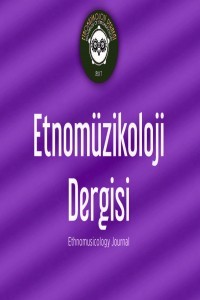TARİHİ NEYLERİN (18.-20.yy) ANALİZİYLE OSMANLI-TÜRK MÜZİĞİNDE REFERANS PERDELERİN ARAŞTIRILMASI
Neyzen Niyazi Sayın’ın “iki ses arasındaki mânevî münâsebet” olarak tanımladığı müzik kümesinde, toplu icra söz konusu olduğunda, enstrümanlar arasındaki ahengi sağlayabilmek için referans bir sese ihtiyaç duyulur. Doğuda ya da batıda durum değişmez; eğer iki enstrüman ile bir icra yapılacak ise birinin diğerine uyması elzemdir. Fakat enstrüman kümesi genişlediğinde artık farklı organolojik yapılar da bu zemine dahil olur ve bazı enstrümanların sabit akortlu olması ya da akord edilmesinin pratik olmaması gibi sebeplerle ortak bir ses / frekans üzerinde birleşilmesi ihtiyacı ortaya çıkar. Çalışma, Avrupa müziğinin bu süreci nasıl yönettiği üzerinden başlayan bir girişle, Osmanlı – Türk müziğinde ney enstrümanının referansında devam eden icra kabiliyetinin, tarih sahnesinde bilinen neyzenlere ait neylerin analiz edilmesiyle ortaya çıkarılmasını amaçlar. Burada elde edilecek tüm veriler ile, teori ya da dönem müziği çalışan araştırmacılara bir model sunulması hedeflenir.
Anahtar Kelimeler:
Hertz, Referans Perdesi, Ney, Osmanlı - Türk Müziği, Frekans
A Study of the Reference Pitches in Ottoman - Turkish Music Through an Analysis of Historical Neys
Ney master Niyazi Sayın defines music as "spiritual relationship” between two sounds, when it comes to collective performance, a reference sound is needed to ensure harmony between the instruments. The situation does not change in East or West; if a performance is to be performed with two instruments, it is essential that one fits the other. However, when the number of instruments increases, different organological structures are included in this situation. The need to unite on a common pitch / frequency has arisen due to reasons such as the fact that some instruments are fixedly tuned or tuning takes hours. In this study, it is aimed to reveal the performance ability that continues in the reference of the ney instrument in Ottoman – Turkish music by analyzing the neys belonging to the important neyzens (ney artists), with an introduction starting with how European music manages this process. All the data obtained here will provide a model for researchers studying theory or period music.
Keywords:
Hertz, Ney, Reference Pitch, Ottoman - Turkish Music, Frequency,
___
- Reference 1 - Cyr, M., (1992). Performing Baroque Music, Amadeus Press, Portland, Oregon.
- Reference 2- Çelebioğlu, E., (1986). Tarihsel Açıdan Evrensel Müziğe Giriş, Üçdal Neşriyat, Istanbul.
- Reference 3- Erkahveci, O., (20 April 2021), Personal Interview, Istanbul.
- Reference 4- Haynes, B., (2002), A history of performing pitch: The story of 'A'. Lanham: The Scarecrow Press, retrieved from Erdal, B., Kındap Tepe, Y., Çelik, S., Güçyetmez, B., Çiğdem, B., & Topraktaş, A. S., (2021). Frekansların sihri – 432 Hz 440 Hz’e karşı: Ayrı frekanslara göre akortlanmış neşeli ve hüzünlü müzikler insan psikofizyolojisi üzerinde farklı etkiler yaratır mı? Müzik ve duygular üzerine bir nöropsikoloji araştırması. International Journal of Human Sciences, vol.18, no.1, 12-33. Doi : 10.14687/jhs.v18i1.6108
- Reference 5- Michels U., Vogel G., (2015) Müzik Atlası, Alfa Basım Yayım Dağıtım, Istanbul.
- Reference 6- Önen U., (2016). Ses Kayıt ve Müzik Teknolojileri, Çitlembik Yayınları, Istanbul,
- Reference 7- Şensöz, A. P., (2008). Barok’tan Modern’e Obuanın Mekani̇k Yapısının Gelişimi, Istanbul University State Conservatory, Institute of Social Sciences, Thesis of DMA (PhD), Istanbul.
- Reference 8- Tan, A., (2011). Ney Açkısının Tarihi ve Teknik Gelişimi, Marmara University Institute of Social Sciences, Doctorate Thesis, Istanbul.
- Reference 9- Yarkın, N., (2019). Geleneksel Türk Müziği Enstrümanlarının Konçertino Kullanımlarıyla, Konçerto Grosso Türünde Eser Çalışması, Istanbul University State Conservatory, Institute of Social Sciences, Thesis of DMA (PhD), Istanbul.
- Digital References Reference 10- Blood, B., (Last modified 2018), Music Theory Online : Pitch, Temperament & Timbre, Web site : https://www.dolmetsch.com/musictheory27.htm (22.02.2021)
- Reference 11- Conversion of Intervals − ¢ = cent , Web Site :http://www.sengpielaudio.com/calculator-centsratio.htm
- Reference 12- Llewelyn S. Lloyd, (1949) A representative of the British Standards Institute hypothesizes how this belief began in “International Standard Musical Pitch, Journal of the Royal Society of Arts, p. 80-81, Retrieved from Cavanagh, L., A brief history of the establishment of international standard pitch A=440 hertz. p.2, Web site : https://www.wam.hr/sadrzaj/us/Cavanagh_440Hz.pdf (22 February 2021)
- Reference 13- What is Baroque Music? (2018) Web Site : https://www.baroque.org/baroque/whatis
- ISSN: 2619-9572
- Yayın Aralığı: Yılda 2 Sayı
- Başlangıç: 2018
- Yayıncı: Etnomüzikoloji Derneği
Sayıdaki Diğer Makaleler
TARİHİ NEYLERİN (18.-20.yy) ANALİZİYLE OSMANLI-TÜRK MÜZİĞİNDE REFERANS PERDELERİN ARAŞTIRILMASI
Performatiflik ve Müziksel Temsil: Karnavalesk Bir Performans Olarak "Huysuz Virjin"
Yorumculuk - Bestecilik Yönlerinden “Variations Sérieuses” ve Nitelikleri
Müzikte Estetiğin Eğitimde Önemi ve Müzik Estetiği Gelişimine Dönemsel Bakış
